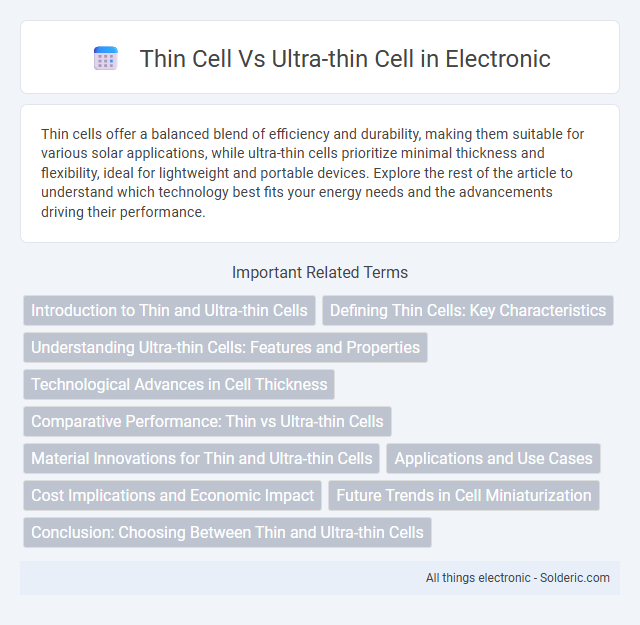Thin cells offer a balanced blend of efficiency and durability, making them suitable for various solar applications, while ultra-thin cells prioritize minimal thickness and flexibility, ideal for lightweight and portable devices. Explore the rest of the article to understand which technology best fits your energy needs and the advancements driving their performance.
Comparison Table
| Feature | Thin Cell | Ultra-Thin Cell |
|---|---|---|
| Thickness | Approximately 100-200 micrometers | Less than 100 micrometers |
| Weight | Lightweight, but heavier than ultra-thin | Extremely lightweight |
| Flexibility | Limited flexibility | Highly flexible, suitable for curved surfaces |
| Application | Standard smartphones, tablets | Wearables, foldable devices, ultra-slim gadgets |
| Battery Efficiency | Moderate energy density | Optimized for high energy density and space efficiency |
| Durability | Good durability | Requires advanced materials for durability |
| Cost | Lower manufacturing cost | Higher production cost due to advanced tech |
Introduction to Thin and Ultra-thin Cells
Thin cells refer to photovoltaic cells with a reduced thickness, typically ranging from a few micrometers to tens of micrometers, designed to enhance flexibility and material efficiency while maintaining high energy conversion rates. Ultra-thin cells push thickness reduction further, often below 5 micrometers, enabling lightweight and flexible applications in wearable technology and portable electronics. Both technologies employ advanced semiconductor materials like silicon or perovskite, optimizing light absorption and electrical performance despite reduced material volume.
Defining Thin Cells: Key Characteristics
Thin cells are defined by their reduced thickness compared to traditional solar cells, typically ranging from 1 to 100 micrometers, which enhances light absorption and flexibility. They utilize materials like amorphous silicon, CdTe, or CIGS, enabling cost-effective production and lightweight design. These characteristics improve performance in flexible and portable solar applications, differentiating thin cells from both traditional thick and ultra-thin cells.
Understanding Ultra-thin Cells: Features and Properties
Ultra-thin cells typically measure less than 100 micrometers in thickness, providing enhanced flexibility and lightweight characteristics compared to standard thin cells, which range around 100-200 micrometers. These ultra-thin cells exhibit improved mechanical resilience and better light absorption due to reduced material layers, leading to higher efficiency in photovoltaic applications. Key properties include superior bending tolerance, faster thermal dissipation, and potential integration into flexible or wearable electronics.
Technological Advances in Cell Thickness
Advancements in solar cell technology have driven the evolution from thin cells, typically around 100 micrometers thick, to ultra-thin cells measuring less than 50 micrometers. Ultra-thin cells leverage cutting-edge materials like perovskites and improved silicon wafer processing to maintain high efficiency while reducing weight and flexibility constraints. These technological innovations enhance photovoltaic performance by optimizing light absorption and minimizing material usage, making ultra-thin cells ideal for lightweight and flexible solar applications.
Comparative Performance: Thin vs Ultra-thin Cells
Thin cells typically offer higher robustness and better thermal management compared to ultra-thin cells, which may sacrifice durability for flexibility and lighter weight. In terms of efficiency, ultra-thin cells often achieve comparable or slightly lower power conversion rates due to reduced material thickness and potential increases in recombination losses. Performance longevity under stress conditions favors thin cells, emphasizing a trade-off between mechanical strength and adaptability in thin versus ultra-thin photovoltaic technologies.
Material Innovations for Thin and Ultra-thin Cells
Material innovations for thin and ultra-thin cells focus on developing flexible substrates, advanced perovskite layers, and lightweight encapsulation techniques to enhance efficiency and durability. Thin cells leverage materials like lightweight polymers and silicon films, while ultra-thin cells incorporate novel 2D materials and nanostructures to maintain mechanical integrity at minimal thicknesses. Your energy solutions benefit from these advancements by delivering high performance with reduced material usage and improved flexibility.
Applications and Use Cases
Thin cells are commonly used in wearable devices and flexible electronics where moderate flexibility and lightweight design are essential, making them ideal for smartwatches and fitness trackers. Ultra-thin cells, with their enhanced bendability and minimal thickness, excel in next-generation foldable smartphones, rollable displays, and advanced medical implants requiring seamless integration with curved surfaces. Your choice between thin and ultra-thin cells depends on the application's need for conformability, durability, and space optimization in compact or dynamic environments.
Cost Implications and Economic Impact
Thin cells generally offer a lower manufacturing cost due to reduced material usage and simpler production processes compared to ultra-thin cells, which require advanced technology and precise handling, increasing overall expenses. The higher initial investment in ultra-thin cells can be offset by greater efficiency and flexibility in application, potentially leading to improved long-term economic returns. Cost implications directly influence market adoption rates, with thin cells presenting an accessible entry point for large-scale solar projects while ultra-thin cells cater to specialized, high-value markets.
Future Trends in Cell Miniaturization
Ultra-thin cells represent the next stage of cell miniaturization, offering enhanced flexibility and integration into wearable and implantable technologies compared to traditional thin cells. Advancements in materials like graphene and perovskites are pushing boundaries, enabling cells to maintain efficiency despite reduced thickness. Future trends point towards the development of nanoscale power sources that seamlessly blend into compact electronic devices, driving innovation in portable energy solutions.
Conclusion: Choosing Between Thin and Ultra-thin Cells
Choosing between thin and ultra-thin cells depends on your device's design priorities, such as flexibility, weight, and durability. Ultra-thin cells offer enhanced portability and sleekness but may compromise slightly on capacity compared to standard thin cells. Evaluating your specific power requirements and space constraints ensures you select the optimal battery solution for reliable performance.
Thin cell vs Ultra-thin cell Infographic

 solderic.com
solderic.com